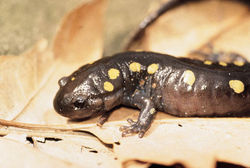- Ambystomatidae
-
Ambystomatidae
?Salamandras topo
Salamandra moteada (Ambystoma maculatum)Clasificación científica Reino: Animalia Filo: Chordata Superclase: Tetrapoda Clase: Amphibia Subclase: Lissamphibia Orden: Caudata Familia: Ambystomatidae Géneros Ver el texto.Las salamandras topo (Ambystomatidae) son un clado de anfibios caudados compuesto por 32 especies endémicas de México y Estados Unidos. El grupo estuvo un tiempo conformada sólo por el género Ambystoma, tras haber incluido a los géneros Dicamptodon y Rhyacotriton, los cuales a su vez pasaron a formar grupos monótípicos. Sin embargo, Frost et al (2006) reubicó a Dicamptodon en Ambystomatidae, siendo este cambio posteriormente aceptado por el Centro de Herpetología de Norteamérica.[1]
Ambystomatidae Dicamptodon Dicamptodon aterrimus
Dicamptodon copei
Dicamptodon ensatus
Dicamptodon tenebrosus
Cladograma basado en Good (1989).[2]
Referencias
- ↑ Frost, D. R. et al. (2006). The Amphibian Tree of Life. Bulletin of the American Museum of Natural History 297: 1–291.
- ↑ Good, D. A. (1989) Hybridization and cryptic species in Dicamptodon (Caudata: Dicamptodontidae). Evolution 43:728-744.
Bibliografía
- Duellman, W. E. 1993. Amphibian Species of the World: Additions and Corrections. Univ. of Kansas Printing Service. Lawrence, KS.
- Duellman, W. E. and L. Trueb. 1986. Biology of Amphibians. McGraw-Hill, New York.
- Estes, R. 1981. Gymnophiona, Caudata. Handbuch der Paläoherpetologie 2:1-115.
- Frost, D. R. (2008) Amphibian Species of the World: an Online Reference. Version 5.2 (15 July, 2008). American Museum of Natural History, New York, USA.
- Hedges, S. B., J. P. Bogart and L. R. Maxson. 1992. Ancestry of unisexual salamanders. Nature 356:708-710.
- Kraus, F. 1988. An empirical evaluation of the use of the ontogeny polarization criterion in phylogenetic inference. Systematic Zoology 37:106-141.
- Kraus, F., P. K. Ducey, P. Moler and M. M. Miyamoto. 1991. Two new triparental unisexual Ambystoma from Ohio and Michigan. Herpetologica 47:429-439.
- Larson, A. 1991. A molecular perspective on the evolutionary relationships of the salamander families. Evolutionary Biology 25:211-277.
- Larson, A. and W. W. Dimmick. 1993. Phylogenetic relationships of the salamander families: A analysis of congruence among morphological and molecular characters. Herpetological Monographs 7:77-93.
- Routman, E. 1993. Population structure and genetic diversity of metamorphic and paedomorphic populations of the tiger salamander, Ambystoma tigrinum. Journal of Evolutionary Biology 6:329-357.
- Shaffer, H. B. 1984. Evolution in a paedomorphic lineage. I. An electrophoretic analysis of the Mexican ambystomatid salamanders. 'Evolution 38:1194-1206.
- Shaffer, H. B., J. M. Clark and F. Kraus. 1991. When molecules and morphology clash: A phylogenetic analysis of the North American ambystomatid salamanders (Caudata: Ambystomatidae). Systematic Zoology 40:284-303.
- Shaffer, H. B. and M. L. McKnight. 1996. The polytypic species revisited: Genetic differentiation and molecular phylogenetics of the tiger salamander, Ambystoma tigrinum (Amphibia: Caudata) complex. Evolution 50:417-433.
- Spolsky, C. M., C. A. Phillips and T. Uzzell. 1992. Antiquity of clonal salamander lineages revealed by mitochondrial DNA. Nature 356:706-708.
- Templeton, A. R., E. Routman and C. A. Phillips. 1995. Separating population structure from population history: A cladistic analysis of the geographical distribution of mitochondrial DNA haplotypes in the tiger salamander, Ambystoma tigrinum. Genetics 140:767-782.
- Twitty, V. C. 1966. Of Scientists and Salamanders. W. H. Freeman and Company. San Francisco, California.
Enlaces externos
 Wikimedia Commons alberga contenido multimedia sobre Ambystomatidae.
Wikimedia Commons alberga contenido multimedia sobre Ambystomatidae.- Ambystomatidae en AmphibiaWeb.
- Dicamptodontidae en AmphibiaWeb.
- Ambystomatidae en Tree of Life.
- Dicamptodontidae en Tree of Life.
Categorías: Anfibios de México | Ambystomatidae
Wikimedia foundation. 2010.
